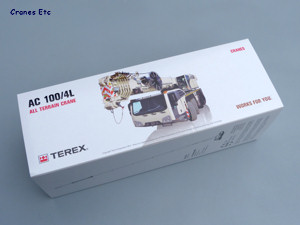 |
| Terex style box.
|
 |
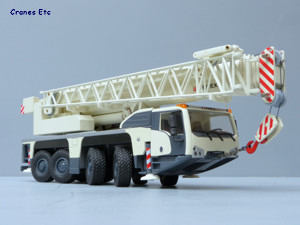 |
| Plastic pulleys
in the boom head. |
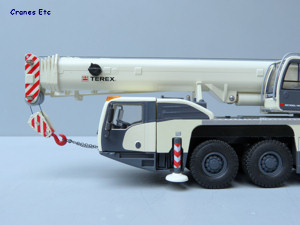 |
| Chain (not included
with the model) used to tie the hook for transport. |
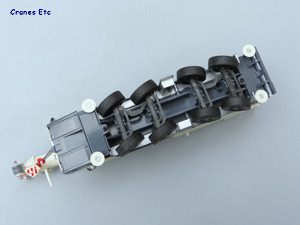 |
| No detail underneath.
|
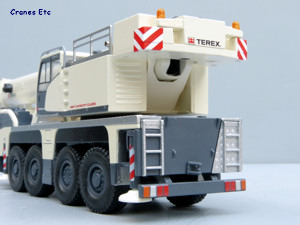 |
| Ladders and painted
lights. |
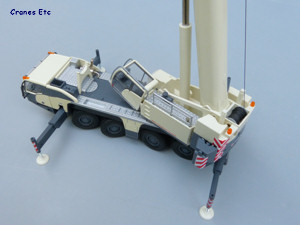 |
| Plenty of diamond
patterned surfaces. |
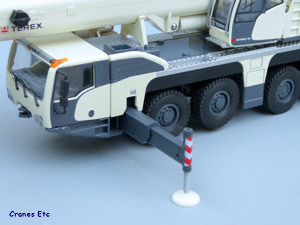 |
|
Two stage plastic outrigger beam. |
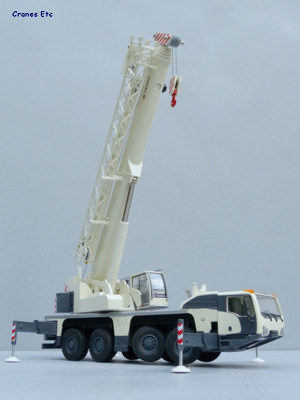 |
|
Set up ready to lift. |
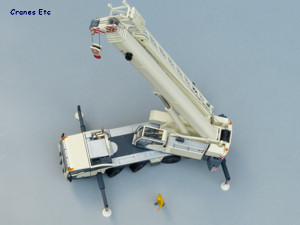 |
|
Fly jib stays on with the boom up. |
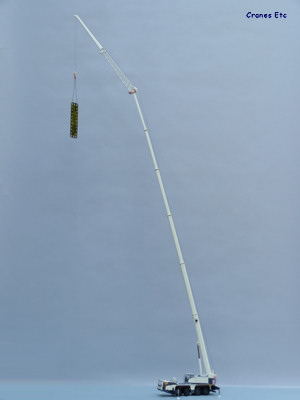 |
|
A big model at full extension. |
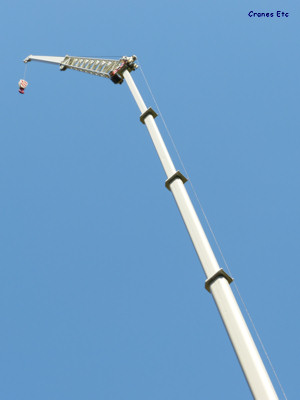 |
|
Reasonably realistic profile. |
|
The Terex 100/4L is nominally a 100
tonne capacity mobile crane with a main boom length of almost
60m. It can carry a 19m overall length double fly
jib and another optional jib extension increases the overall
system length to almost 82m.
The model does not include the optional jib extension.
Packaging
The model comes in standard two piece expanded polystyrene
trays held together by a picture sleeve which has a photo
of the real machine, and a graphic of the extended boom.
The review model had no defects or missing parts.
There are no instructions provided with the model which
would be disappointing for an inexperienced collector.
Nevertheless assembly is reasonably straight forward.
Detail
There is little detail on the underside of the chassis with
the steering mechanism for the axles being purely functional.
The wheels have good all terrain tyres and it is good to
see that the wheel design for axle 3 is different from those
on the other three driven axles.
The outrigger beams are made of tough plastic and the pistons
are standard screw threads, with plastic pads.
The driving cab has door mirrors and stylised beacon lights
on the roof. The headlights have small plastic lenses
and there is a towing hitch although it is too small for
the hook to fix onto directly whilst travelling. Interior
detail inside the cab is reasonable.
Behind the cab, the carrier deck has diamond plated anti-slip
surfaces and a couple of ladders is formed within the casting.
At the rear of the carrier the lights are painted and there
is another small towing hitch.
The crane cab has plastic grab rails and inside there is
an operator's seat and controls, with the computer console
having detail. The rest of the body is simple, with
some metal hand rails. The counterweight comes in
six separate pieces including the cheek weights. The
main slabs have lifting points which could be used to attach
thin chains.
The boom sections are diecast metal and fairly simple, and
the top section of the telescope ends up narrow due to the
modelling tolerances in diecast. There is a small
spooling drum on the lowest section but the larger spool
shown on the box photo is not modelled. In the boom
head the pulleys are plastic and free rolling. The
fly jib has a convincing metal lattice work section and
the swingaway part is plastic although the colour match
is excellent.
A single pulley hook is provided, and the pulley is metal,
and the block has nice red and white stripes.
Features
The steering works very well and consists of linked front
and rear pairs of axles. This means crab steering
can be simulated, but not all the steering modes of the
real crane as axles 3 and 4 are not independent.
The outrigger beams are two stage and can be pulled out
to any extension and the pads lowered. They can successfully
hold the weight of the crane.
The crane cab tilts smoothly to a good angle.
A good feature is the counterweight which can be attached
to simulate different configurations, and it can be fully
posed on the carrier deck in the middle or at the rear.
All the usual crane functions work fine with the crane rotating
and the boom able to be set at a reasonable angle, and the
boom cylinder is stiff enough to hold a pose. The
six section telescopic boom can be smoothly extended to
full length and each section has the usual locking mechanism
to prevent the boom retracting.
The fly jib is pinned to the boom head using small plastic
bolts and can be fixed to be straight, or at one of two
offset angles. The swingaway portion can be pinned
into position or left retracted so overall the fly jib provides
a variety of display options.
The winch is operated by turning the winch drum directly
and it has enough friction to hold a reasonable load.
Quality
The model is robust and strong. The paintwork and graphics
are good although the Terex factory livery is minimalistic.
Price
It is a little pricey for a four axle crane model.
Overall
This is an interesting model because of the modern cab styling
and it will look very good in an interesting colour scheme.
It has a couple of improvements over the AC100/4 model including
a longer boom, and is certainly recommended.
Footnotes
The model first appeared at the Nuremberg Toy Fair in
2012 and was available soon after. A version in Felbermayr's
colours was also produced as model
2107/01 and a
version also appeared in Bruns colours.
|
|
|
|
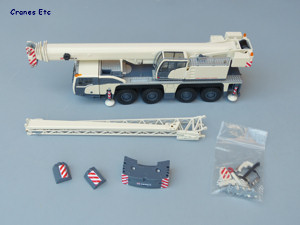 |
| The parts the box.
|
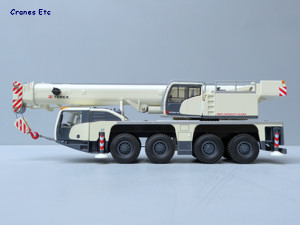 |
| Profile view |
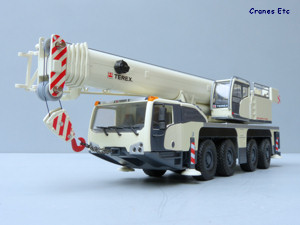 |
| Modern cab design.
|
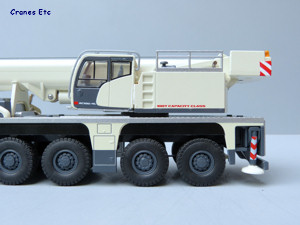 |
| Graphics are understated
in the Terex livery. |
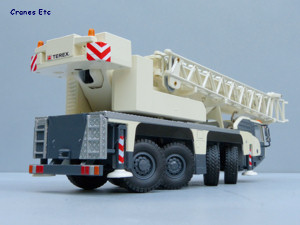 |
| Fly jib stowed
on the side. |
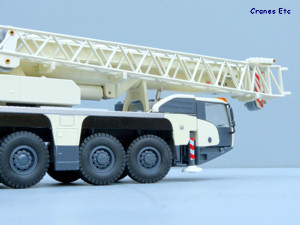 |
| Axle 3 has a slightly
different wheel design. |
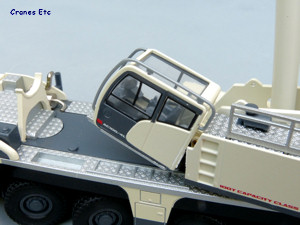 |
| Tilting cab.
|
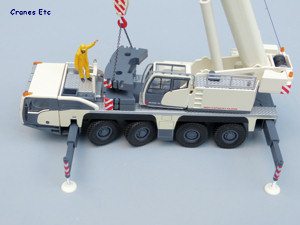 |
| Loading the counterweight.
|
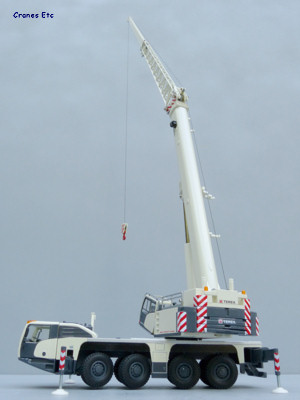 |
| Fly jib attached. |
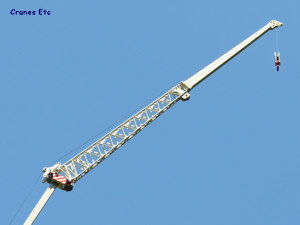 |
| Swingaway fly jib
opened up. |
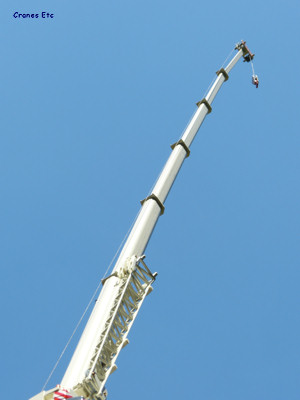 |
| Lifting on the
main boom only. |
|

